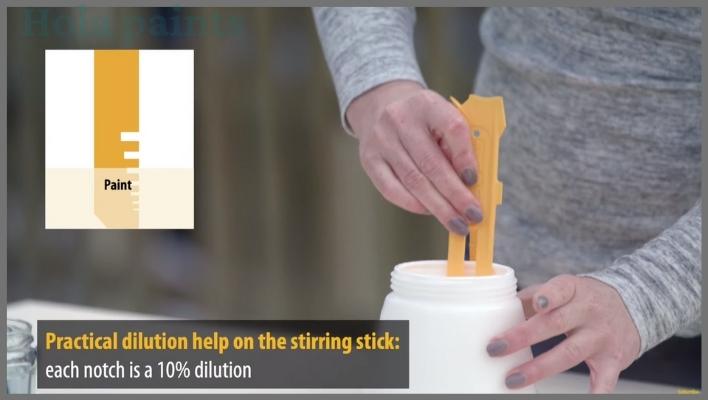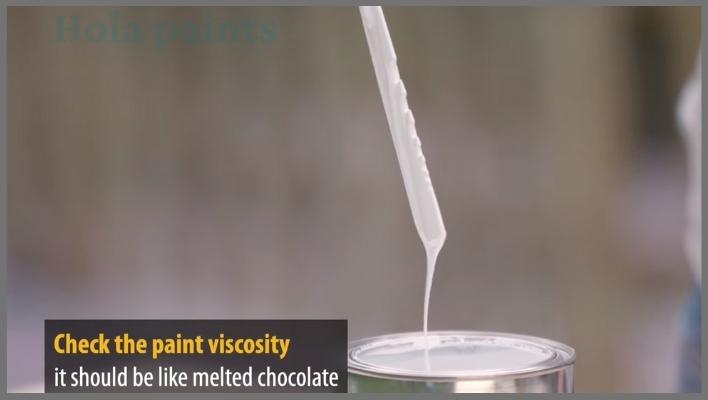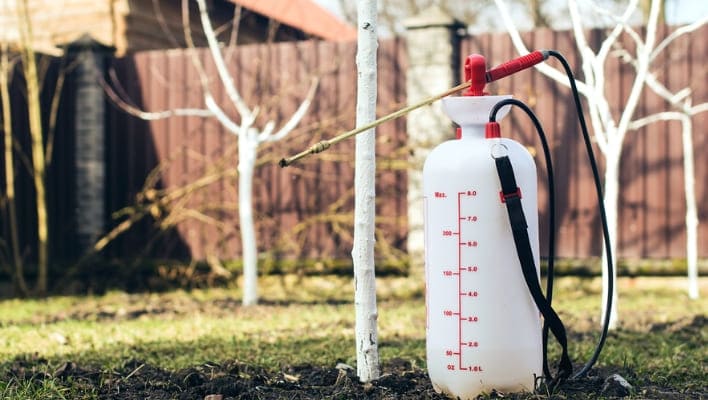Have you ever wondered why your spray gun’s nose gets clogged with paint? And it always seems to happen at the most inconvenient time, like after you just climbed a 2-story ladder or when you’re in a hurry so much so that you may wish to avoid the paint getting dried when you have last painted. So clogged paint for a spray gun is a clear indication that the paint is thick and would not allow us to spray smoothly. It is an obvious problem for painters.
A successful spray painting project requires the right painting technique and thinning the paint before spraying. We have tried various painting jobs after thinning paint for the sprayer, the experience seems smoother, and the result is far more pleasing. Therefore, we must know how to thin paint for a sprayer!
Table of Contents
- Thinning Paint For Sprayer
- How To Thin Paint For A Sprayer: Be Prepared With The Right Equipment!
- * Is It Best To Thin Latex Paint Before Spraying It?
- How to thin latex paint for sprayer?
- * Thinning Paint For Spraying Acrylic Paints
- How to thin acrylic paint for sprayer?
- * Thinning oil-Based Paint For Spray Guns:
- * What Is The Best Way To Thin Emulsion Paint For Spray Guns?
- When to Thin Emulsion Paint:
- Thinning Emulsion Paint with Water:
- Tools for Thinning and Spraying:
- Cleaning Up:
- Final Inspection:
- Conclusion On How To Thin Paint For Sprayer!
- FAQs (How To Thin Paint For Sprayer?)
- How much paint to the thinner ratio for sprayer do we need?
- What is the best way to thin paint?
- Can water be used to thin out paint?
- Can I solve the problem of too thin paint?
- Is adding water to latex paint a good idea?
Thinning Paint For Sprayer
If you want to use different kinds of paint, you need to thin them differently. Spray guns use three types of paint globally.
1- Acrylic-based paint
2- Latex-based paint
3- Oil-based paint
We are sharing the pro tips we have learned from using these spray paints that can be helpful with your projects.
Once you learn the correct way to thin paint, you will not have to change paints or spray guns as frequently due to clogged nozzles. In this guide from Holapaints.com, painters like you will discover how to thin paint for sprayers, and you will also learn how to:
- Check the paint’s consistency before spraying.
- Prepare the tools for thinned paint.
Ideally, we need to know the paint to the thinner ratio for a spray gun to simplify the whole process. We find that water and paints have distinct properties.
Paints are made from several compounds and chemicals, all of which act in different ways and have different viscosities, which can clog a paint gun and affect the drying time. As a result, you will be adding different amounts of water each time you thin paint for spraying. Since that is true, learning how to do it is much more valuable than being told how much water to use.
How To Thin Paint For A Sprayer: Be Prepared With The Right Equipment!

1- Paint- Generally, paint is classified into two groups: water-based paints or latex paint and oil-based paint or alkyd paint. You need to have enough paint available at your end to color the surface. As there is no way to color the surface you are covering without paint.
2- Thinners such as water are commonly used to thin paint for latex paints.
Generally, paint thinners were made of the following solvents:
- Turpentine
- Acetone
- Naphtha
- Toluene
- Methyl ethyl ketone
- Mineral spirits or White spirit
- Lacquer thinner
- Any of the glycol ethers, including 2-Butoxyethanol
3- A funnel will be necessary for you to determine the paint’s viscosity. To ensure when the paint is at the right consistency.
4- Spray gun– You can use thinning paint for professional airless sprayers, HVLP sprayers, handheld Wagner or Graco sprayers for painting purposes.
5- Test surface- It is best to use a small piece of cardboard or another test surface so you can spray the thinned paint on it and make sure it adheres to the surface.
* Is It Best To Thin Latex Paint Before Spraying It?
It is necessary to thin latex paint before using handheld sprayers, airless paint sprayers, or HVLP sprayers due to their thick consistency. You can thin paint with water, which is a fairly simple process, and add the paint to a cup and stir gently. Check out the entire process below.
How to thin latex paint for sprayer?
Start by opening the paint container and thoroughly blending the paint. If a machine has already mixed the paint in a store, Then you may skip this step.
Step 1: ( Thinning Latex Paint For Sprayer )
At first, you must be highly cautious. You need 12-13 ounces of water per gallon of paint, and it is a 10% volume requirement for every gallon of paint. If you want the perfect consistency for your sprayer tips, you should use a paint strainer. Please be advised to use a stir stick to mix the latex paint for a spray gun.
Step 2:
A funnel is an open-ended test to determine whether the paint’s consistency is suitable for spraying latex paint. You should see the mixture flow freely from the end of the funnel if you pour it slowly.
Do not waste any paint or water by doing this open-ended funnel test over a bucket or a mixture of paint and water.
You should take the next step if the first pass did not result in the free-flowing fluid. If a clog is found, you can try using a strainer.
Step 3:

The volume of the paint that we have used previously was 10 percent. You may need to mix paint 10% at a time and gradually increase the amount required.
There is a crucial spot where the paint is not too diluted, yet it flows well through the funnel, especially since the spot is different for each type of paint. Do not jump up to increase the ratio drastically because you may miss it.
Step 4:

Once the paint is properly thinned, you can test it out and spray it on the sample surface after loading it into the sprayer.
As a result, your spray will spread uniformly, and you will not have problems getting stuck or slowed down. If the paint is clogged in the nozzle of the sprayer or it feels like it is slowed down, you might need to mix the paint again.
Step 5: (HVLP for Latex Paint)
You can now spray paint any surface you wish using the smooth experience. Plus, your paint is likely to last longer since you thinned it during the mixing process, which saves you money and increases the life of your paint.
Mainly, a minimum of 10% of latex paint per quarter cup of water should be used when thinning latex paint. Increasing the water percentage by 20-30% when using an HVLP sprayer or handheld system might be necessary.
* Thinning Paint For Spraying Acrylic Paints
Thinning acrylic paint for spraying is easy due to its water-based formulation. Thinning paint for sprayers requires a certain amount of care, as you should not overdo it. Adding too much water to the paint can cause it to flake off because too much water will affect their ability to bond.
How to thin acrylic paint for sprayer?
Acrylic latex paint
Acrylic paint can be mixed up to 50% with water when applied to an absorbent surface. However, it is advised to avoid mixing more than 30% of the water on any other surface.
* Thinning oil-Based Paint For Spray Guns:
It is necessary to thin oil-based paints, like semi-gloss enamels, before applying them to the surface. Oil-based paints tend to be slightly thinner than latex paints but still need to be thinned for best results. You can determine the ratio of paint to thinner in a spray gun by reading the manual guide.
In the guide, you will need to find which thinner is best for the oil-based paint since water is not the best choice. Most oil-based paints need 10% thinner. Learn more about thinning oil based paints.
* What Is The Best Way To Thin Emulsion Paint For Spray Guns?
Emulsion paint, frequently denoted as water-based paint, stands out as a favored option for indoor painting because of its rapid drying characteristics and user-friendly nature. Before utilizing emulsion paint, it’s essential to grasp some key aspects.
When to Thin Emulsion Paint:
Emulsion paint may need thinning in the following scenarios:
- Thin the paint if you intend to use a paint sprayer to achieve a smoother finish.
- When the paint has thickened over time, it might require thinning.
- Thin the paint to achieve a more consistent finish on your walls.
Thinning Emulsion Paint with Water:
Water is a commonly used agent to thin emulsion paint. Follow these steps:
- Pour the emulsion paint into a mixing container or paint tray.
- While stirring continuously, slowly incorporate water.
- To maintain consistency, it’s important to continue stirring and gradually add water until you achieve the desired thickness.
Caution: Avoid adding excessive water all at once to prevent over-thinning.
Ideal Consistency for Spraying: If using a sprayer, aim for the following consistency:
- A typical ratio for thinning emulsion paint for spraying is 70% paint and 30% water.
- Some painters may prefer an 80/20 ratio, depending on the specific paint and its thickness.
- Look for a creamy, pourable texture that allows the paint to flow smoothly through the sprayer without any clogging issues.
Tools for Thinning and Spraying:
Ensure you have the necessary tools:
- Paint Tray: You’ll need a suitable container for mixing the paint.
- Stir Stick: You can use stir stick can to thoroughly stir the paint.
- Quality Paint Sprayer: Invest in a high-quality paint sprayer suitable for emulsion paint.
Preparing the Surface:
- Clean the surface, sand it, and address any imperfections.
- Proper preparation ensures a smoother and longer-lasting finish.
Testing and Adjusting:
Before applying paint broadly, conduct a test:
- Apply a small section of paint to assess coverage, texture, and color.
- If needed, make adjustments to the paint’s consistency before starting your main project.
Spraying Technique:
When using a sprayer, employ these techniques for a professional finish:
- Maintain Consistent Distance: Keep a consistent distance from the wall while spraying.
- Overlap Passes: Overlap each pass by approximately 30% to ensure even coverage.
- When using a sprayer, it’s advisable to adopt a top-to-bottom approach to prevent drips.
Cleaning Up:
Upon completing the painting task, thoroughly clean your tools and sprayer with water. Dispose of any remaining paint following local regulations.
Final Inspection:
In the final inspection stage, once the paint has dried, thoroughly examine the walls for any imperfections, and address them by touching up to achieve a flawless finish.
Conclusion On How To Thin Paint For Sprayer!
This article about how to thin paint for sprayers might be of interest to you. Hopefully, you enjoyed it!
Thinning paint for sprayers is essential for several reasons. In the first place, paint sprayers cannot function properly if the paint is too thick. It also ensures an even coating with a fine finish. Finally, using thin paint for spraying minimizes waste and allows you to cover a larger area with it.
Now, you can complete your paint job without damaging your paint rifle or spray gun, and without leaving the messy spots to contend with, you will be fine.
After using it, be sure to clean out the spray gun. You can make your life much easier by following these steps, which hopefully will make your project turns out to be great.
FAQs (How To Thin Paint For Sprayer?)
How much paint to the thinner ratio for sprayer do we need?
Manufacturers often specify a ratio of paint to thinner on paint container labels. Painters should maintain a greater quantity of paint than paint thinner. A 4:1 or 3:1 ratio of paint to thinner or a similar ratio works well for general purpose thinning paint. You should keep the paint quantity higher than that of paint thinner to achieve the best results.
What is the best way to thin paint?
Professionals usually take one part mineral spirits, or turpentine to three parts paint to make the paint flow better and for even consistency. Mix well with a stick. Try out the spray pattern on a test area and examine the results. You can add thinner if the paint remains thick.
Can water be used to thin out paint?
If stirring does not thin your water-based paint out, you can try adding as little water as possible before adding any liquid. Mix the can properly after adding an ounce or two of water. Next, you can gradually add water to reach the right consistency.
Can I solve the problem of too thin paint?
It is an excellent approach to Thin water-based or latex paint with half a cup of water. When you add too much water at once, this could lead to problems. The result would not be as professional as you expect.
To fix this issue, you can gradually add half a cup of paint to the container to thin the paint and stir it well. If necessary, add more paint with constant stirring each time. Repeat until you can easily pass the paint through the funnel.
Is adding water to latex paint a good idea?
Latex is a type of water-based paint that can be thinned with water, especially if it is to be applied by spray gun or nozzle. It would help if you thinned latex paint with care to achieve the desired viscosity while avoiding over-thinning.

Jennifer Marie
Jennifer Marie is a general contractor with over the years of experience in home remodeling, DIY projects, and commercial painting projects. Her experience includes working with paint sprayers, painting tools, and other painting supplies. You can follow her on Facebook.


